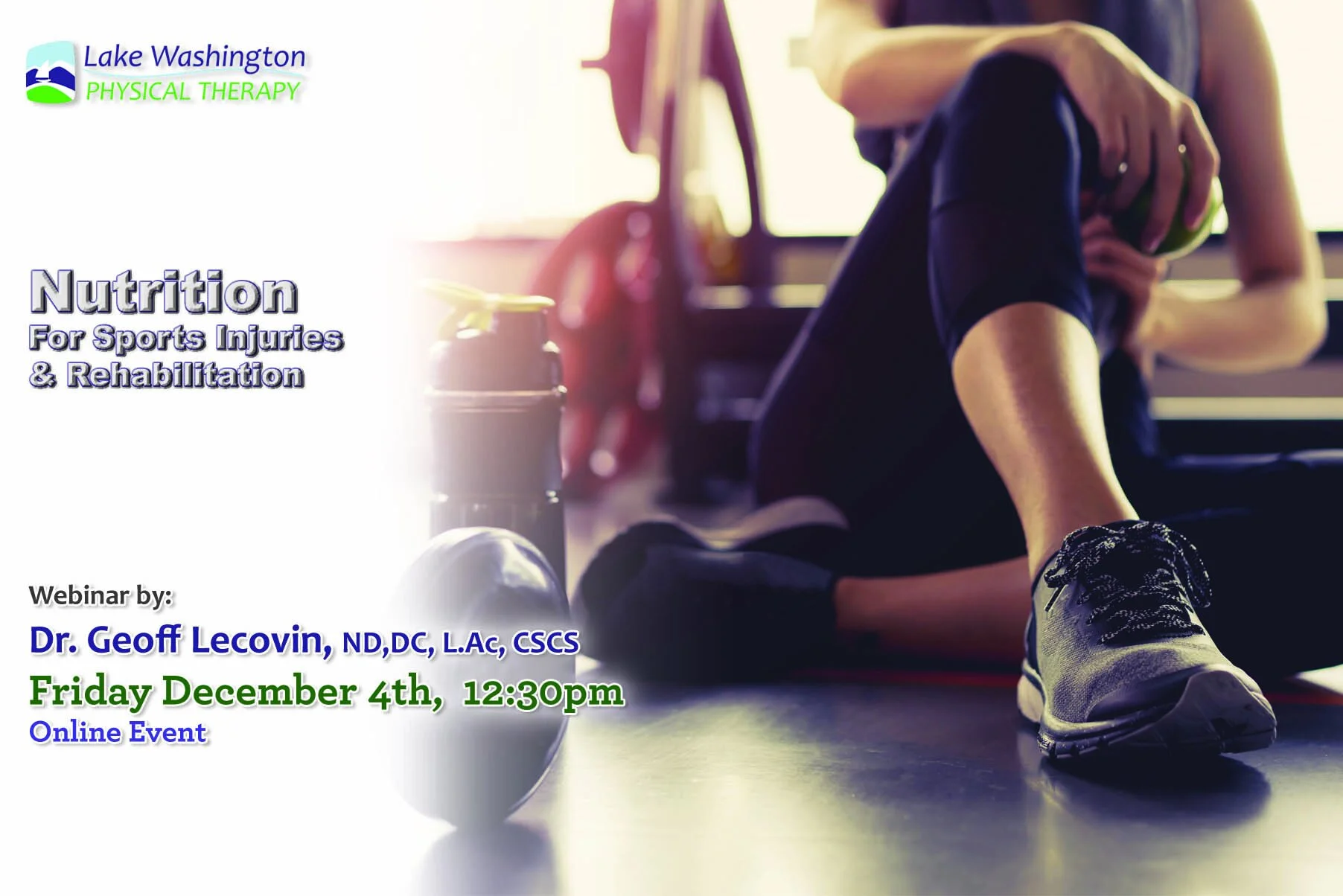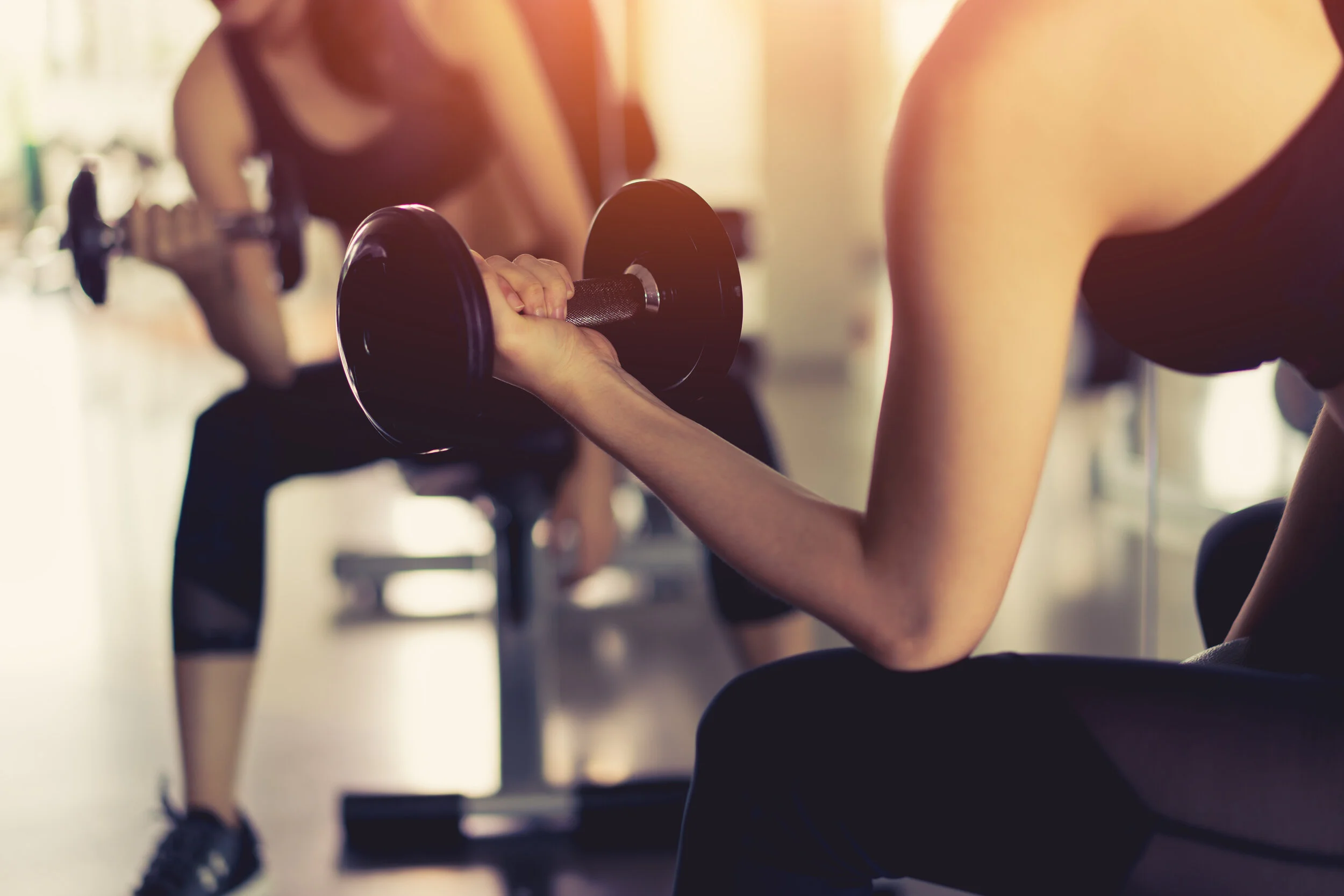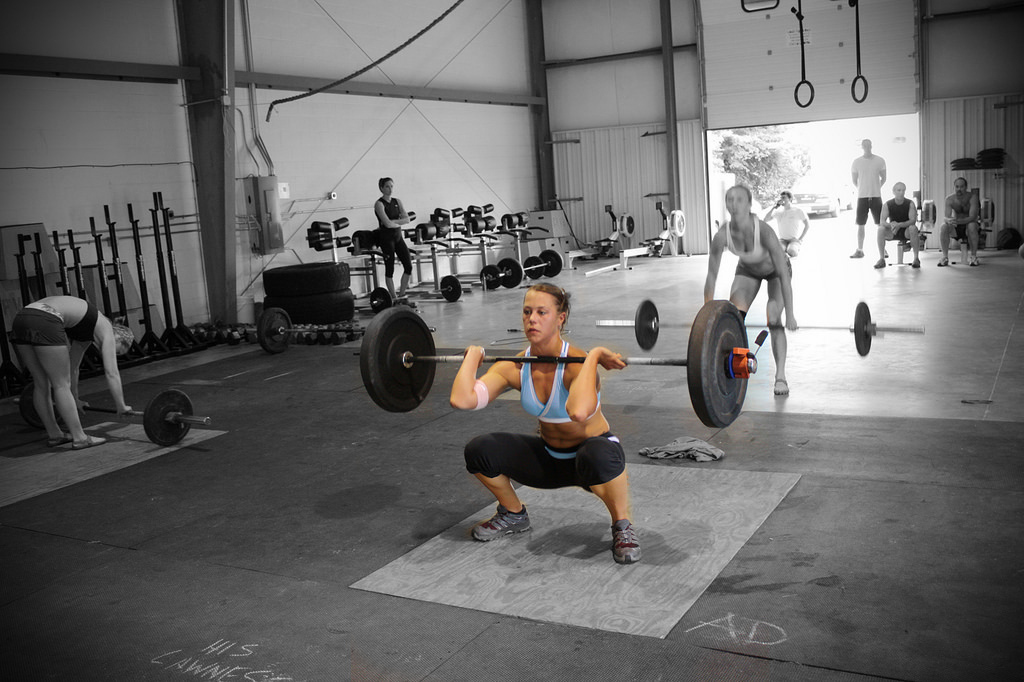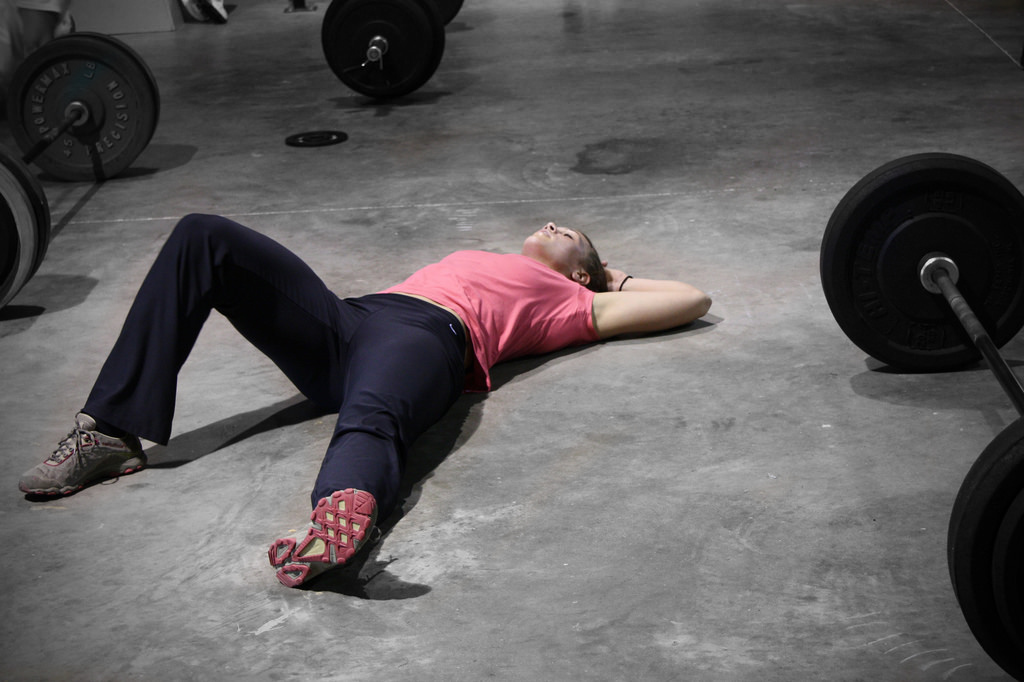Dr. Geoff Lecovin joins us for a 3 part series on healthy diet and nutrition for rehabilitation.
Nutrition for Sports Injuries & Healing: Part 2 of 3
Nutrition for Sports Injuries & Healing: 2 of 3
Dr. Geoff Lecovin
MS, DC, ND, L.Ac, CSCS, CISSN
Naturopathic Physician, Chiropractor, Acupuncturist, Nutritionist, & Personal Trainer
“Unleashing the Power of Food”
The key points to consider with the pyramid of nutritional
Prioritization:
Consume adequate calories to ensure energy balance
Ensure optimal intake of macronutrients (Carbohydrates, proteins and fats) for energy, repair and reducing inflammation
Eat enough nutrient dense foods to avoid micronutrient deficiencies (vitamins, minerals and phytonutrients)
Strategic timing of nutrients for energy and repair
Select nutrient supplementation for inflammation, muscle, tendon and bone repair
Energy
Adequate calories (energy) are essential for maintaining ideal body weight, fueling activities (e.g. rehabilitation) and promoting healing/recovery. Determining one’s energy requirements can be done using online calculators that take into account one's metabolic rate (BMR) and activity energy expenditure (i.e. rehabilitation, exercise, healing requirements and non exercise activity thermogenesis). Many individuals reduce their calorie intake during injury recovery out of fear that they will gain weight. While consuming excessive simple carbohydrates could lead to unwanted weight gain, supporting the healing process with adequate calories is essential. In addition, some weight gain may be favorable for optimal healing. Also, during recovery, the use of crutches or other ambulation aids can substantially increase one’s energy requirements.
Macronutrients
There are three macronutrients:
Carbohydrates
Proteins
Fats
Each macronutrient plays an important role in the healing process and will be discussed in the context of the three T’s: Total, Type and Timing.
Carbohydrates
Carbohydrates include sugars (simple) and starches (complex). Their primary function is to provide energy for moderate-intense activity. They are also important in keeping the body in an anabolic state by helping to mediate cortisol levels, a main catabolic hormone. Carbohydrates also spare protein, which further aids in maintaining an anabolic state. During injury healing, one should consider meeting carbohydrate requirements for both the healing process as well as rehabilitation. This could be in the range of 3-5g/kg Body Mass, with the focus on low glycemic carbohydrates (e.g. whole grains, vegetables and fruits) as the primary sources.
Proteins
Proteins are essential for muscle growth and repair as well as keeping the body in an anabolic state. They can be categorized as:
Complete - Animal sources, such as beef, poultry, pork, lamb, fish, eggs, dairy and plants such as quinoa and soy
Incomplete - Plants, such as grains, legumes, nuts and vegetables
The general dose for protein to help support healing is 1.5-2.5 g/kg Body Mass. Include some protein with each meal (about 0.4 g/kg Body Mass or about 20-40g). If you are vegetarian, make sure to balance complementary protein sources throughout the day, e.g. Rice and beans, and aim for intakes towards the higher end. Protein needs can be higher in older adults as well as in disuse atrophy, where there can be anabolic resistance.
Fats
Fats and oils can be categorized according to their saturation. The degree of saturation determines the melting point and stability of a fat. Fats are important as an energy source (low intensity activity), hormone production and in controlling inflammation.
Sources of fats include:
Saturated fats- Animal fats and coconut Monounsaturated- Avocados, olive oil, macadamia nuts
Polyunsaturated:
Omega 6 (Proinflammatory if out of balance)- Seed and vegetable oils, e.g. canola, corn, peanut, sunflower, safflower
Omega 3 (anti-inflammatory)- Dark green leafy vegetables, flax/hemp seeds, walnuts, cold water fish, grass-fed beef, omega-3 eggs
In general, fats should make up anywhere from 15-20% of one’s diet, with the emphasis on omega 3 polyunsaturated fatty acids and monounsaturated sources. Diets high in saturated fats and omega 6 polyunsaturated fatty acids can put the body in a more inflammatory state.
Micronutrients
Micronutrients include vitamins, minerals and phytonutrients. They are required in small quantities to ensure normal metabolism, growth and physical well-being. They also help to reduce inflammation and support the healing process. When it comes to micronutrients, avoiding nutrient deficiencies is the key and this can be done by eating a well balanced, varied, whole foods and unprocessed diet. Supraphysiologic vitamin and mineral supplementation beyond what a balanced diet can provide, is not recommended and in the case of antioxidants (e.g. Vitamins A,C,E,Beta carotene, Zinc and Selenium) can adversely affect healing by disrupting the beneficial aspects of inflammation.
References:
Areestion during prolta, J. L., Burke, L. M., Ross, M. L., Camera, D. M., West, D. W., Broad, E. M., ... & Hawley, J. A. (2013).
Timing and distribution of protein ingonged recovery from resistance exercise alters myofibrillar protein synthesis. The Journal of physiology , 591 (9), 2319-2331 Louise M. Burke, John A. Hawley, Stephen H. S. Wong & Asker E. Jeukendrup (2011)
Carbohydrates for training and competition, Journal of Sports Sciences, 29:sup1, S17-S27, DOI: 10.1080/02640414.2011.585473 Clifford, T., Bell, O., West, D. J., Howatson, G., & Stevenson, E. J. (2016).
The effects of beetroot juice supplementation on indices of muscle damage following eccentric exercise. European journal of applied physiology , 116 (2), 353-362. Close, G. L., Sale, C., Baar, K., & Bermon, S. (2019).
Nutrition for the prevention and treatment of injuries in track and field athletes. International journal of sport nutrition and exercise metabolism , 29 (2), 189-197 Currell , Kevin. Performance Nutrition . Crowood Press (April 1, 2017)
Farup, J., Rahbek, S. K., Knudsen, I. S., de Paoli, F., Mackey, A. L., & Vissing, K. (2014). Whey protein supplementation accelerates satellite cell proliferation during recovery from eccentric exercise. Amino Acids , 46 (11), 2503-2516 Frankenfield, D. (2006).
Energy expenditure and protein requirements after traumatic injury. Nutrition in Clinical Practice , 21 (5), 430-437 Glover, E. I., Phillips, S. M., Oates, B. R., Tang, J. E., Tarnopolsky, M. A., Selby, A., ... & Rennie, M. J. (2008).
Immobilization induces anabolic resistance in human myofibrillar protein synthesis with low and high dose amino acid infusion. The Journal of physiology , 586 (24), 6049-6061 Guo, S., & Dipietro, L. A. (2010).
Factors affecting wound healing. Journal of dental research , 89 (3), 219–229. https://doi.org/10.1177/0022034509359125 Juhasz, I., Kopkane, J. P., Hajdu, P., Szalay, G., Kopper, B., & Tihanyi, J. (2018).
Creatine Supplementation Supports the Rehabilitation of Adolescent Fin Swimmers in Tendon Overuse Injury Cases. Journal of sports science & medicine , 17 (2), 279–288 Kelley, D. S., Adkins, Y., & Laugero, K. D. (2018).
A Review of the Health Benefits of Cherries. Nutrients , 10 (3), 368. https://doi.org/10.3390/nu10030368 Kerksick, C. M., Arent, S., Schoenfeld, B. J., Stout, J. R., Campbell, B., Wilborn, C. D., Taylor, L., Kalman, D., Smith-Ryan, A. E., Kreider, R. B., Willoughby, D., Arciero, P. J., VanDusseldorp, T. A., Ormsbee, M. J., Wildman, R., Greenwood, M., Ziegenfuss, T. N., Aragon, A. A., & Antonio, J. (2017).
International society of sports nutrition position stand: nutrient timing. Journal of the International Society of Sports Nutrition , 14 , 33. https://doi.org/10.1186/s12970-017-0189-4 Laumonier, T., & Menetrey, J. (2016).
Muscle injuries and strategies for improving their repair. Journal of experimental orthopaedics , 3 (1), 15. https://doi.org/10.1186/s40634-016-0051-7 Logue, D. M., Madigan, S. M., Melin, A., Delahunt, E., Heinen, M., Donnell, S. M., & Corish, C. A. (2020). Low Energy Availability in Athletes 2020:
An Updated Narrative Review of Prevalence, Risk, Within-Day Energy Balance, Knowledge, and Impact on Sports Performance. Nutrients , 12 (3), 835. https://doi.org/10.3390/nu12030835 Phillips, C. M., Chen, L. W., Heude, B., Bernard, J. Y., Harvey, N. C., Duijts, L., ... & Shivappa, N. (2019).
Dietary inflammatory index and non-communicable disease risk: a narrative review. Nutrients , 11 (8), 1873. Maughan, R. J., Burke, L. M., Dvorak, J., Larson-Meyer, D. E., Peeling, P., Phillips, S. M., ... & Meeusen, R. (2018).
IOC consensus statement: dietary supplements and the high-performance athlete. International journal of sport nutrition and exercise metabolism , 28 (2), 104-125 Myer, G. D., Kushner, A. M., Brent, J. L., Schoenfeld, B. J., Hugentobler, J., Lloyd, R. S., Vermeil, A., Chu, D. A., Harbin, J., & McGill, S. M. (2014).
The back squat: A proposed assessment of functional deficits and technical factors that limit performance. Strength and conditioning journal , 36 (6), 4–27. https://doi.org/10.1519/SSC.0000000000000103 Mountjoy, M., Sundgot-Borgen, J., Burke, L., Carter, S., Constantini, N., Lebrun, C., ... & Ljungqvist, A. (2014).
The IOC consensus statement: beyond the female athlete triad—Relative Energy Deficiency in Sport (RED-S). Br J Sports Med , 48 (7), 491-497 Pence, B. D., & Woods, J. A. (2014). Exercise, obesity, and cutaneous wound healing: evidence from rodent and human studies. Advances in wound care , 3 (1), 71-79. Quintero, K. J., de Sá Resende, A., Leite, G. S. F., & Junior, A. H. L. (2018).
An overview of nutritional strategies for recovery process in sports-related muscle injuries. Nutrire , 43 (1), 27 Sale, C., & Elliott-Sale, K. J. (2019). Nutrition and athlete bone health. Sports Medicine , 1-13 Shaw, G., Lee-Barthel, A., Ross, M. L., Wang, B., & Baar, K. (2017).
Vitamin C–enriched gelatin supplementation before intermittent activity augments collagen synthesis. The American journal of clinical nutrition , 105 (1), 136-143 Smith, Stephen, MSc, PHd, (Cand), NUTRITION FOR INJURY PREVENTION & REHABILITATION applied in an elite powerlifter.2019.
IOPN Performance Nutrition DiplomaTipton, K. D. (2015).
Nutritional support for exercise-induced injuries. Sports Medicine , 45 (1), 93-104 Van Vliet, S., Shy, E. L., Abou Sawan, S., Beals, J. W., West, D. W., Skinner, S. K., ... & Moore, D. R. (2017).
Consumption of whole eggs promotes greater stimulation of postexercise muscle protein synthesis than consumption of isonitrogenous amounts of egg whites in young men. The American journal of clinical nutrition , 106 (6), 1401-1412 Wall, B. T., Snijders, T., Senden, J. M., Ottenbros, C. L., Gijsen, A. P., Verdijk, L. B., & van Loon, L. J. (2013). Disuse impairs the muscle protein synthetic response to protein ingestion in healthy men. The Journal of Clinical Endocrinology & Metabolism , 98 (12), 4872-4881 Yang, D. F., Shen, Y. L., Wu, C., Huang, Y. S., Lee, P. Y., Er, N.X., ... & Tung, Y. T. (2019).
Sleep deprivation reduces the recovery of muscle injury induced by high-intensity exercise in a mouse model. Life sciences , 235 , 116835 Precision Nutrition, Nutrition for Injury Recovery Infographic. https://www.precisionnutrition.com/ http://www.sportsrd.org/wp-content/uploads/2016/08/Nutrition- Support-for-Inury-Recovery-Return-to-Play.pdf
Questions and Contact Info: www.drgeofflecovin.com or email: geoff@drgeofflecovin.com
Nutrition for Sports Injuries & Healing
Nutrition for Sports Injuries & Healing: 1 of 3
Dr. Geoff Lecovin
MS, DC, ND, L.Ac, CSCS, CISSN
Naturopathic Physician, Chiropractor, Acupuncturist, Nutritionist, & Personal Trainer
“Unleashing the Power of Food”
Healing after an Injury occurs in three stages
1. Inflammation - Occurs immediately and continues up to 5 days post-injury. It is the body's way of signaling the immune system to heal and repair damaged tissue, as well as defend itself against viruses and bacteria.
2. Proliferation (regeneration) - From 5 days to 3 weeks post-injury. In this phase, tissue rebuilding and repairing occurs.
3. Maturation (fibrosis) - From 3 weeks to 2 years. In this phase, remodeling of tissue structure occurs. Each stage must occur sequentially in order for optimal healing to occur. By understanding the stages of healing, one can more effectively focus specific nutrition and rehabilitation interventions. Should you use ice and/or anti-inflammatory medications after an injury?
Healing after an Injury occurs in three stages
1. Inflammation - Occurs immediately and continues up to 5 days post-injury. It is the body's way of signaling the immune system to heal and repair damaged tissue, as well as defend itself against viruses and bacteria.
2. Proliferation (regeneration) - From 5 days to 3 weeks post-injury. In this phase, tissue rebuilding and repairing occurs.
3. Maturation (fibrosis) - From 3 weeks to 2 years. In this phase, remodeling of tissue structure occurs. Each stage must occur sequentially in order for optimal healing to occur. By understanding the stages of healing, one can more effectively focus specific nutrition and rehabilitation interventions. Should you use ice and/or anti-inflammatory medications after an injury?
During the inflammatory stage, numerous chemicals are released, some of which can irritate pain receptors called nociceptors. Many people turn to Non Steroidal Anti-inflammatory Drugs, such as Ibuprofen and Naproxen, to reduce the pain. Unfortunately, while these medications can be effective at blocking pain, they can also disrupt the healing process. Fortunately, there are a number of alternative physical and nutritional interventions that can help reduce the pain associated with inflammation, while at the same time supporting the healing process.
MEAT vs RICE?
Move, Exercise, Analgesics, Treatment
Rest, Ice, Compression, Elevation
MEAT supports the healing process, whereas certain aspects of RICE may impede it, depending upon the injury. I generally recommend contrast hydrotherapy as follows: Three minutes of heat alternating with one minute cold, three times, several times throughout the day. This serves to pump nutrition into the injured area and pump waste products out. Ice is generally reserved for right after surgery or briefly after an injury, depending on the severity of the inflammation. You should consult your doctor or therapist to determine which approach best suits your injury.
References:
Areestion during prolta, J. L., Burke, L. M., Ross, M. L., Camera, D. M., West, D. W., Broad, E. M., ... & Hawley, J. A. (2013).
Timing and distribution of protein ingonged recovery from resistance exercise alters myofibrillar protein synthesis. The Journal of physiology , 591 (9), 2319-2331 Louise M. Burke, John A. Hawley, Stephen H. S. Wong & Asker E. Jeukendrup (2011)
Carbohydrates for training and competition, Journal of Sports Sciences, 29:sup1, S17-S27, DOI: 10.1080/02640414.2011.585473 Clifford, T., Bell, O., West, D. J., Howatson, G., & Stevenson, E. J. (2016).
The effects of beetroot juice supplementation on indices of muscle damage following eccentric exercise. European journal of applied physiology , 116 (2), 353-362. Close, G. L., Sale, C., Baar, K., & Bermon, S. (2019).
Nutrition for the prevention and treatment of injuries in track and field athletes. International journal of sport nutrition and exercise metabolism , 29 (2), 189-197 Currell , Kevin. Performance Nutrition . Crowood Press (April 1, 2017)
Farup, J., Rahbek, S. K., Knudsen, I. S., de Paoli, F., Mackey, A. L., & Vissing, K. (2014). Whey protein supplementation accelerates satellite cell proliferation during recovery from eccentric exercise. Amino Acids , 46 (11), 2503-2516 Frankenfield, D. (2006).
Energy expenditure and protein requirements after traumatic injury. Nutrition in Clinical Practice , 21 (5), 430-437 Glover, E. I., Phillips, S. M., Oates, B. R., Tang, J. E., Tarnopolsky, M. A., Selby, A., ... & Rennie, M. J. (2008).
Immobilization induces anabolic resistance in human myofibrillar protein synthesis with low and high dose amino acid infusion. The Journal of physiology , 586 (24), 6049-6061 Guo, S., & Dipietro, L. A. (2010).
Factors affecting wound healing. Journal of dental research , 89 (3), 219–229. https://doi.org/10.1177/0022034509359125 Juhasz, I., Kopkane, J. P., Hajdu, P., Szalay, G., Kopper, B., & Tihanyi, J. (2018).
Creatine Supplementation Supports the Rehabilitation of Adolescent Fin Swimmers in Tendon Overuse Injury Cases. Journal of sports science & medicine , 17 (2), 279–288 Kelley, D. S., Adkins, Y., & Laugero, K. D. (2018).
A Review of the Health Benefits of Cherries. Nutrients , 10 (3), 368. https://doi.org/10.3390/nu10030368 Kerksick, C. M., Arent, S., Schoenfeld, B. J., Stout, J. R., Campbell, B., Wilborn, C. D., Taylor, L., Kalman, D., Smith-Ryan, A. E., Kreider, R. B., Willoughby, D., Arciero, P. J., VanDusseldorp, T. A., Ormsbee, M. J., Wildman, R., Greenwood, M., Ziegenfuss, T. N., Aragon, A. A., & Antonio, J. (2017).
International society of sports nutrition position stand: nutrient timing. Journal of the International Society of Sports Nutrition , 14 , 33. https://doi.org/10.1186/s12970-017-0189-4 Laumonier, T., & Menetrey, J. (2016).
Muscle injuries and strategies for improving their repair. Journal of experimental orthopaedics , 3 (1), 15. https://doi.org/10.1186/s40634-016-0051-7 Logue, D. M., Madigan, S. M., Melin, A., Delahunt, E., Heinen, M., Donnell, S. M., & Corish, C. A. (2020). Low Energy Availability in Athletes 2020:
An Updated Narrative Review of Prevalence, Risk, Within-Day Energy Balance, Knowledge, and Impact on Sports Performance. Nutrients , 12 (3), 835. https://doi.org/10.3390/nu12030835 Phillips, C. M., Chen, L. W., Heude, B., Bernard, J. Y., Harvey, N. C., Duijts, L., ... & Shivappa, N. (2019).
Dietary inflammatory index and non-communicable disease risk: a narrative review. Nutrients , 11 (8), 1873. Maughan, R. J., Burke, L. M., Dvorak, J., Larson-Meyer, D. E., Peeling, P., Phillips, S. M., ... & Meeusen, R. (2018).
IOC consensus statement: dietary supplements and the high-performance athlete. International journal of sport nutrition and exercise metabolism , 28 (2), 104-125 Myer, G. D., Kushner, A. M., Brent, J. L., Schoenfeld, B. J., Hugentobler, J., Lloyd, R. S., Vermeil, A., Chu, D. A., Harbin, J., & McGill, S. M. (2014).
The back squat: A proposed assessment of functional deficits and technical factors that limit performance. Strength and conditioning journal , 36 (6), 4–27. https://doi.org/10.1519/SSC.0000000000000103 Mountjoy, M., Sundgot-Borgen, J., Burke, L., Carter, S., Constantini, N., Lebrun, C., ... & Ljungqvist, A. (2014).
The IOC consensus statement: beyond the female athlete triad—Relative Energy Deficiency in Sport (RED-S). Br J Sports Med , 48 (7), 491-497 Pence, B. D., & Woods, J. A. (2014). Exercise, obesity, and cutaneous wound healing: evidence from rodent and human studies. Advances in wound care , 3 (1), 71-79. Quintero, K. J., de Sá Resende, A., Leite, G. S. F., & Junior, A. H. L. (2018).
An overview of nutritional strategies for recovery process in sports-related muscle injuries. Nutrire , 43 (1), 27 Sale, C., & Elliott-Sale, K. J. (2019). Nutrition and athlete bone health. Sports Medicine , 1-13 Shaw, G., Lee-Barthel, A., Ross, M. L., Wang, B., & Baar, K. (2017).
Vitamin C–enriched gelatin supplementation before intermittent activity augments collagen synthesis. The American journal of clinical nutrition , 105 (1), 136-143 Smith, Stephen, MSc, PHd, (Cand), NUTRITION FOR INJURY PREVENTION & REHABILITATION applied in an elite powerlifter.2019.
IOPN Performance Nutrition DiplomaTipton, K. D. (2015).
Nutritional support for exercise-induced injuries. Sports Medicine , 45 (1), 93-104 Van Vliet, S., Shy, E. L., Abou Sawan, S., Beals, J. W., West, D. W., Skinner, S. K., ... & Moore, D. R. (2017).
Consumption of whole eggs promotes greater stimulation of postexercise muscle protein synthesis than consumption of isonitrogenous amounts of egg whites in young men. The American journal of clinical nutrition , 106 (6), 1401-1412 Wall, B. T., Snijders, T., Senden, J. M., Ottenbros, C. L., Gijsen, A. P., Verdijk, L. B., & van Loon, L. J. (2013). Disuse impairs the muscle protein synthetic response to protein ingestion in healthy men. The Journal of Clinical Endocrinology & Metabolism , 98 (12), 4872-4881 Yang, D. F., Shen, Y. L., Wu, C., Huang, Y. S., Lee, P. Y., Er, N.X., ... & Tung, Y. T. (2019).
Sleep deprivation reduces the recovery of muscle injury induced by high-intensity exercise in a mouse model. Life sciences , 235 , 116835 Precision Nutrition, Nutrition for Injury Recovery Infographic. https://www.precisionnutrition.com/ http://www.sportsrd.org/wp-content/uploads/2016/08/Nutrition- Support-for-Inury-Recovery-Return-to-Play.pdf
Questions and Contact Info: www.drgeofflecovin.com or email: geoff@drgeofflecovin.com
Squat Depth
By: Jordan Bork, PT, DPT, CSCS
Squat Depth: A Physical Therapist’s Perspective
One of the most debated topics in the weight lifting world is that of squat depth. At most gyms you will see everything from mini-knee bends, to “A*s to Grass” squatting. So how do you know how deep is deep enough?
Anatomy and Biomechanics:
As per usual, let’s cover a quick lesson in anatomy and biomechanics before we dive into the debate.
The classic barbell squat primarily works your gluteal and quadriceps muscle groups. Together with the hamstrings, calves, abductors and adductors, the body works to control the weight as you descend and ascend throughout the lift. Because of its large compound movement the squat it is often considered a full body work out and one of the 3 major lifts (along with deadlifts and bench press).
During the lowering (eccentric) phase of a squat several of your muscles contract as they elongate to control the speed at which you descend. At the hips, the gluteals and hamstrings work to prevent rapid hip flexion. At the knees, the quadriceps serve to slow down the amount of knee bend you have, and at your feet the calf muscles work to control how much dorsiflexion occurs at your ankles. During the upward (concentric) phase of a squat the same muscles are engaged again. This time they activate in the opposite manor, meaning that they shorten as you stand up. The gluteals and hamstrings work to straighten your hips, the quadriceps activate to extend the knees, and the calf muscles work to push into the ground.
In addition to muscular activation and strength, several anatomic factors impact the squat. Core strength, hip mobility and bone structure all dictate your ideal form. You must be able to correctly stabilize the spine as you move through your squat by keeping the low back in a neutral position. This means the low back should be relatively straight and not rounded, curved or arched. Hip mobility plays a key role in achieving lower positions at the bottom of a squat. The amount of rotation throughout your lower leg dictates how wide your stance should be and ankle mobility affects how far down you can move before your heels come off the ground.
Personal Differences: So what do you do?
Your body is the only one that can truly answer the question of how far down you should be squatting. Don’t get too caught up when someone tells you to never go past 90 degrees or to always squat butt to the ground. You should be squatting as low as you can while maintaining a tight core and a neutral back. Once you feel your pelvis tilt backwards and your lower back flatten, you have gone too far. Everyone’s breaking point may be slightly different. For example, individuals with relatively long legs compared to their torso will have a difficult time keeping their weight on their heels, making it harder to go past parallel without rounding the back.
As for those who advocate squatting to the floor, I would caution that you should go as low as your form allows. Studies have found that the quadriceps muscle contracts with high levels of activity at 90 degrees of knee bend. This means that if you are going excessively deep in hopes of working a larger range of motion (ROM), the potential gains might not be much more than stopping at parallel. It certainly means that the risk vs. the reward of squatting lower than your form allows probably isn’t worth it.
You should also be aware that even if your form is perfect, squatting greatly increases the stress and compression placed upon your knees and spine. This is because the nature of the movement redirects force vectors and places your muscles at a mechanical disadvantage, requiring them to overcome forces much greater than the poundage on the bar. Individuals with hip, knee, or low back conditions should place extra consideration into whether or not squatting is the ideal form of strengthening for them.
Bottom Line
Squat as low as your form allows. There is no single correct depth that everyone should be squatting to. Personal factors such as hip mobility and core strength impact the ideal squat depth. If you are unsure how to analyze your squat form than keep a couple things in mind. Throughout the motion you should keep a tight core and maintain a neutral spine position. This means having no curve or bend in the low back. If you feel your hips/pelvis dipping forward or backward you likely have gone too far. If you are reading this in attempt to find a quick guideline for your lifts, without assessment of your technique then I would recommend you squat to 90 degrees of knee bend. This will help prevent form breakdown and avoid placing excessive stress through the low back while still providing you adequate ROM for significant strength gains.
Side Notes:
Common Technique pitfalls while squatting:
Valgus Collapse of the Knees:
Valgus collapse is the inward bending of the knees as if they were moving together into a “knock- kneed” position. This often occurs when the lateral hip muscles are not strong enough to stabilize the weight you are squatting and as a result your knees tip inward while the gluteus medius is overpower. I often see this technical error at the sticking point (or bottom) of a squat right as the person is pushing into the ground to return to the standing position.
Anterior Translation of the Knees:
Translation of the knees over the toes means that your knees are moving too far forward out over your toes as you go into the low position of a squat. This usually occurs when you are not sitting your buttock backward enough or you are placing too much weight through the balls of your feet. Keep your heels on the ground and your weight placed through the back half of your foot throughout your squats.
Overall, you should be putting those gym mirrors to good use. Don’t just admire your biceps in between sets; observe your knees as you go down into the squat. Don’t let them dive inwards or move out past your toes. If you are unable to consistently do this than lower your weight to a resistance level you can.
To learn more on weight lifting and strength training keep an eye out for upcoming articles on the Lake Washington Physical Therapy website.











